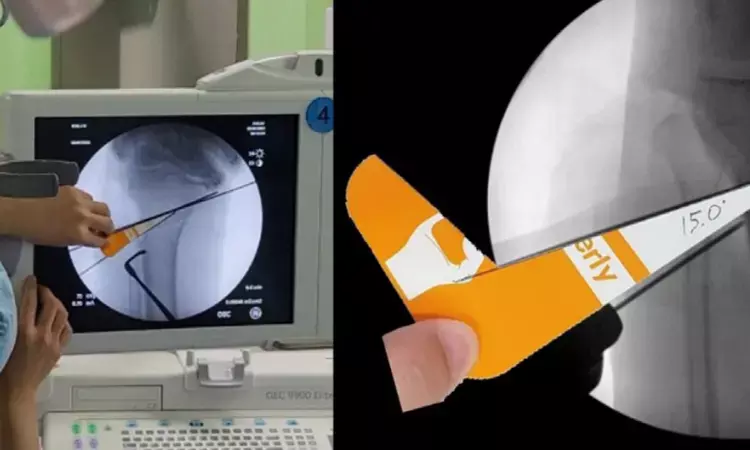- Home
- Medical news & Guidelines
- Anesthesiology
- Cardiology and CTVS
- Critical Care
- Dentistry
- Dermatology
- Diabetes and Endocrinology
- ENT
- Gastroenterology
- Medicine
- Nephrology
- Neurology
- Obstretics-Gynaecology
- Oncology
- Ophthalmology
- Orthopaedics
- Pediatrics-Neonatology
- Psychiatry
- Pulmonology
- Radiology
- Surgery
- Urology
- Laboratory Medicine
- Diet
- Nursing
- Paramedical
- Physiotherapy
- Health news
- Fact Check
- Bone Health Fact Check
- Brain Health Fact Check
- Cancer Related Fact Check
- Child Care Fact Check
- Dental and oral health fact check
- Diabetes and metabolic health fact check
- Diet and Nutrition Fact Check
- Eye and ENT Care Fact Check
- Fitness fact check
- Gut health fact check
- Heart health fact check
- Kidney health fact check
- Medical education fact check
- Men's health fact check
- Respiratory fact check
- Skin and hair care fact check
- Vaccine and Immunization fact check
- Women's health fact check
- AYUSH
- State News
- Andaman and Nicobar Islands
- Andhra Pradesh
- Arunachal Pradesh
- Assam
- Bihar
- Chandigarh
- Chattisgarh
- Dadra and Nagar Haveli
- Daman and Diu
- Delhi
- Goa
- Gujarat
- Haryana
- Himachal Pradesh
- Jammu & Kashmir
- Jharkhand
- Karnataka
- Kerala
- Ladakh
- Lakshadweep
- Madhya Pradesh
- Maharashtra
- Manipur
- Meghalaya
- Mizoram
- Nagaland
- Odisha
- Puducherry
- Punjab
- Rajasthan
- Sikkim
- Tamil Nadu
- Telangana
- Tripura
- Uttar Pradesh
- Uttrakhand
- West Bengal
- Medical Education
- Industry
Hybrid Lateral Closed-Wedge High Tibial Osteotomy shows similar Outcomes compared to Opening-Wedge High Tibial Osteotomy

Seung Joon Rhee et al conducted a study to compare the accuracy of applied correction angle between hybrid lateral closed wedge high tibial osteotomy (hybrid HTO) and medial open wedge high tibial osteotomy (OWHTO), and verify previous reports on hybrid HTO by matching correction angle between groups.
Hybrid HTO was performed according to the original surgical technique reported by Takeuchi et al. with the exception of the application of correction angle and management of the fibula.
A total of 50 OWHTO patients were selected for 2:1 propensity matching with 25 hybrid HTO patients. Rate of correction error was calculated by dividing the difference between the change in medial proximal tibial angle and preoperatively planned correction angle (PRD) by planned correction angle. Accuracy of angular correction was assessed using PRD and correction error rates. Hip-knee-ankle axis, mechanical lateral distal femoral angle, medial proximal tibial angle, joint line convergence angle, and length of the entire lower limb and tibia were measured. The Caton-Deschamps index (CDI) was used to assess change in patellar height. Serial postoperative radiographic analysis was performed to assess the union rate.
Key findings of the study were:
• The discrepancy between planned correction angle and real correction angle was 0.8 ± 2.3 in hybrid HTO and 1.1 ± 3.4 in OWHTO (P > .05), and the rate of error in osteotomy was similar between the groups approximately 6%.
• Postoperatively, posterior tibial slope (PTS) (P < .001), tibia length, and CDI (P < .001) were significantly different between groups.
• The amount of change in PTS (P < .001), tibia length in hybrid HTO (P < .001), and CDI (P < .001) were significantly different between groups.
• Union rate of osteotomy site was significantly faster in hybrid HTO than in OWHTO (P < .001).
The authors concluded that - “Although hybrid HTO has floating hinge point which may be unreliable for the center of correction, hybrid HTO showed similar accuracy in angular correction compared to correction angle matched OWHTO. Reduction in posterior tibial slope, maintained patellar height relative to the proximal tibia, and faster osteotomy site union was also confirmed in this matched comparative study. More attempts of hybrid HTO are encouraged based on its various radiological and clinical advantages with reliability.”
Further reading:
Hybrid Lateral Closed-Wedge High Tibial Osteotomy Showed Similar Accuracy in Angular Correction and Reduction of Posterior Tibial Slope Compared to Opening-Wedge High Tibial Osteotomy: A Correction Angle Matched Cohort Study
Seung Joon Rhee, Ji Hoon Kim et al
The Journal of Arthroplasty
https://doi.org/10.1016/j.arth.2023.02.027
For surgical technique:
Takeuchi R, Ishikawa H, Miyasaka Y, Sasaki Y, Kuniya T, Tsukahara S. A novel closed-wedge high tibial osteotomy procedure to treat osteoarthritis of the knee: hybrid technique and rehabilitation measures. Arthrosc Tech 2014;3: e431.
MBBS, Dip. Ortho, DNB ortho, MNAMS
Dr Supreeth D R (MBBS, Dip. Ortho, DNB ortho, MNAMS) is a practicing orthopedician with interest in medical research and publishing articles. He completed MBBS from mysore medical college, dip ortho from Trivandrum medical college and sec. DNB from Manipal Hospital, Bengaluru. He has expirence of 7years in the field of orthopedics. He has presented scientific papers & posters in various state, national and international conferences. His interest in writing articles lead the way to join medical dialogues. He can be contacted at editorial@medicaldialogues.in.
Dr Kamal Kant Kohli-MBBS, DTCD- a chest specialist with more than 30 years of practice and a flair for writing clinical articles, Dr Kamal Kant Kohli joined Medical Dialogues as a Chief Editor of Medical News. Besides writing articles, as an editor, he proofreads and verifies all the medical content published on Medical Dialogues including those coming from journals, studies,medical conferences,guidelines etc. Email: drkohli@medicaldialogues.in. Contact no. 011-43720751


